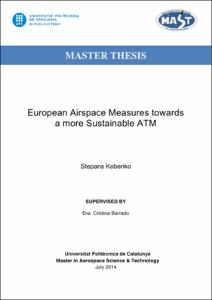Mostra el registre d'ítem simple
European airspace measures towards a more sustainable ATM
| dc.contributor | Barrado Muxí, Cristina |
| dc.contributor.author | Kobenko, Stepans |
| dc.contributor.other | Universitat Politècnica de Catalunya. Departament d'Arquitectura de Computadors |
| dc.date.accessioned | 2015-11-04T15:29:51Z |
| dc.date.available | 2015-11-04T15:29:51Z |
| dc.date.issued | 2014-07-08 |
| dc.identifier.uri | http://hdl.handle.net/2117/78788 |
| dc.description.abstract | The following work will be aiming to investigate the level of how the airspace is being operated under the current conditions and propose the most appealing way to be implemented in order to meet the requirements of capacity increase. Air Traffic Management operates a set of services aiming primary at ensuring safety of flights. The services in Europe are provided by various ATM systems, including controllers, control centers and airports, managing approximately of 30000 daily flights and providing aircraft separations, collision preventing and providing information. The assuring predictions made for the year 2030, is estimated for Air Traffic to double. If nothing will be done we are to be expected, flight cancellations, missed connections and negative impact on safety. Traffic growth cannot be sustained with the current divided air navigation services organization and some ageing ATM technologies. It must be recognized that the air transport must be grown in a sustainable manner, where the future of European ATM system will cope with expected growth in air Traffic. There is a need for one simplified European framework to cope safely with the increased demand. Hence a new Air Traffic Management System is required for the benefit of the European Sky. The possible solutions for the traffic management is provided by SESAR, the goal of which is to enable EU skies to handle 3 times more traffic, improving safety of flights and decreasing of ATM cost and cost per flight. The creating of change of change in European ATM will demonstrate the ability to deliver benefits to the Air Transport community. A performance-based approach will be used for the development of the future ATM system, with common objective: to handle up to three times more traffic than today and decrease in ATM cost per flight. (by 2020) The area navigation and navigation performance specifications have to be globally harmonized for a set of Performance Based Navigation, which defines the performance requirements for aircraft navigation within the Air Traffic Service route. By simulating the possible outcome for the future planning, we will look into how or which of the ways is more attractive to be applied in order to meet the requirements of increasing capacity, in the airspace field. For this we will use Nest desktop application, used by the EUROCONTROL, for airspace structure design and development, preparing scenario for fast and real time simulation. Nest is a scenario-based tool, where we can make changes to the original dataset scenario to model an unlimited number of different operation planning options, also to generate future traffic samples using traffic growth forecasts provided by STATFOR (Statistics and Forecasts). Data will be taken from the Demand Data Repository project, objective of which is to provide airspace users with the a potential accurate outcome of the past and future European air traffic demand, to meet their planning and monitoring needs. |
| dc.language.iso | eng |
| dc.publisher | Universitat Politècnica de Catalunya |
| dc.subject | Àrees temàtiques de la UPC::Aeronàutica i espai |
| dc.subject.lcsh | Air traffic control |
| dc.subject.other | SESAR Air traffic Eurocontrol NEST ICAO |
| dc.title | European airspace measures towards a more sustainable ATM |
| dc.type | Master thesis |
| dc.subject.lemac | Navegació aèria |
| dc.rights.access | Open Access |
| dc.date.updated | 2014-07-11T06:36:13Z |
| dc.audience.educationlevel | Màster |
| dc.audience.mediator | Escola d'Enginyeria de Telecomunicació i Aeroespacial de Castelldefels |


